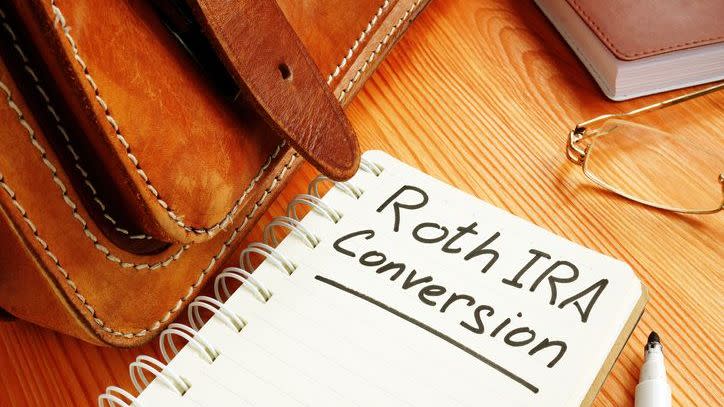I'm 65 Years Old With $1.2 Million in an IRA. I'm Taking Social Security – Is It Too Late to Convert to a Roth IRA?

Imagine you’re 65 with $1.2 million in an IRA and a lingering question: should you convert your account into a Roth IRA? The answer may depend on how you go about it. A Roth conversion can provide some sizable advantages, including tax-free withdrawals and freedom from mandated distributions – but that doesn’t mean it’s always the right move.
While there’s no prohibition or disadvantage to a Roth conversion based on your age at 65, converting the entire $1.2 million all at once will burden you with a larger tax bill than you may want to pay in a single year. If you use partial Roth conversions tailored to your situation, however, you can significantly reduce your tax burden and also provide for a tax-free inheritance later. If you need additional guidance surrounding Roth conversions and other retirement planning topics, speak with a financial advisor today.
Roth IRA Conversion Concepts
A Roth conversion shifts retirement money from a traditional IRA to a Roth IRA. Traditional pre-tax IRAs let you deduct contributions from taxable income when you contribute, but withdrawals in retirement are taxed according to your income tax bracket that year.
Roth IRA contributions use after-tax dollars, so you don’t get a tax break when you make contributions. Qualified withdrawals can be made tax-free later, though. Another big plus is that Roth accounts are not subject to required minimum distributions (RMDs), which can bump you into a higher tax bracket in retirement. Without RMDs, Roth funds can stay invested and grow tax-free forever, being passed down to your heirs if that’s part of your estate plan. There’s also no income limit on Roth conversions, unlike direct contributions to a Roth IRA that can only be made by individuals with less than $161,000 in modified adjusted gross income (MAGI) and married couples filing jointly with MAGI less than $240,000.
But Roth conversions carry a significant catch. The money you convert in a given year becomes ordinary income in the year in which it’s converted. That means paying taxes on that money – lots of them potentially. Turning $1.2 million into taxable Roth conversion income could trigger the 37% top federal rate, plus state taxes in most states. One alternative approach for reducing this potential tax hit is to do partial conversions, spreading a large amount over several years to avoid bumping you into a higher bracket.
And if you want to talk through your options with an expert, consider using this free matching tool to find a financial advisor.
Lump Sum vs. Incremental Conversions

As a single 65-year-old with $1.2 million in a traditional IRA, let’s assume you collect $24,000 in annual Social Security income, which is slightly more than the most recent average retirement benefit of $1,856 per month. If you converted the full $1.2 million IRA balance to a Roth IRA in 2023 and took the standard deduction ($15,700 in 2023 for people 65 and older), all or nearly all of the converted amount could be subject to the top tax rate of 37%. This could result in a one-time tax federal income bill of over $398,000 due in April 2024, plus more if state taxes apply.
Need help with a Roth conversion? Find a financial advisor today.
There may be a better way, though. Spreading the $1.2 million conversion over 10 years at $120,000 per year puts you in the 22% tax bracket in tax year 2023 after taking the standard deduction. That means paying approximately $18,430 in federal taxes annually on the portion that gets converted. Over the decade, that totals around $184,300 for a total tax savings of roughly $214,000. (While tax brackets change from year to year, we’re assuming you’ll remain in the 24% bracket for simplicity’s sake.)
People under 59.5 years old should be mindful of the five-year rule when doing a Roth conversion. Withdrawing money from a Roth account less than five years after a conversion may trigger a 10% penalty. However, that rule doesn't apply to people who are 59.5 or older, as well as others who qualify for certain exceptions.
More Roth Conversion Considerations
There are some other factors to keep in mind. For one, adding taxable income from a Roth conversion may increase taxes on your Social Security benefits. You may also have to pay higher Medicare premiums and lose access to some tax credits.
Also, the money you leave in the Roth while doing partial conversions will likely continue to grow, so you’ll have to convert more than $120,000 in later years to empty the account. Furthermore, future tax rates may increase. These uncertainties mean that any projections of taxes owed on the gradual conversion plan may vary significantly from the actual amounts you’ll owe. Converting everything now provides certainty – you’ll know exactly how much you have to pay.
Deciding If a Roth Conversion Is Right

There are a lot of moving parts when evaluating a large Roth conversion. You may want to follow this process and speak with a financial advisor to get a better understanding of how this maneuver will affect your outlook:
Determine how you want to handle IRA money at your death. If the objective is completely tax-free inheritance, calculated partial Roth conversions can maintain that tax-free growth for heirs over time.
Compare current and future expected tax rates. Paying taxes now on a lump sum conversion or a series of larger conversions may ultimately save you if tax rates increase in the future.
Consider other elements of your financial plan. Examine your income streams, multi-year tax outlook, healthcare costs and estate plan. To pick the Roth conversion method that fits you best will likely require a careful and comprehensive analysis of your financial outlook.
Bottom Line
While you can do a Roth conversion at any age, converting an entire $1.2 million IRA into a Roth account all at once will typically saddle you with a large tax bill. However, partial Roth conversions tailored specifically for you can help considerably. Check retirement spending plans, estate planning, health budgets and more before opting for a conversion. Also, consider potential changes to tax rates in the future and how they could impact you.
Retirement Planning Tips
A financial advisor can help you evaluate whether a Roth IRA conversion makes sense for you. Finding a financial advisor doesn’t have to be hard. SmartAsset’s free tool matches you with up to three vetted financial advisors who serve your area, and you can have a free introductory call with your advisor matches to decide which one you feel is right for you. If you’re ready to find an advisor who can help you achieve your financial goals, get started now, get started now.
SmartAsset’s Social Security calculator is a quick and easy way to project the size of your monthly check after you claim your benefits. If you’re considering relocating to a new state for retirement, it’s important to assess the tax environment of that state. SmartAsset’s retirement tax friendliness tool can help you do that.
Photo credit: ©iStock.com/designer491, ©iStock.com/Pekic, ©iStock.com/insta_photos
The post I’m 65 Years Old With $1.2 Million in an IRA. I’m Taking Social Security – Is It Too Late to Convert to a Roth IRA? appeared first on SmartReads by SmartAsset.
